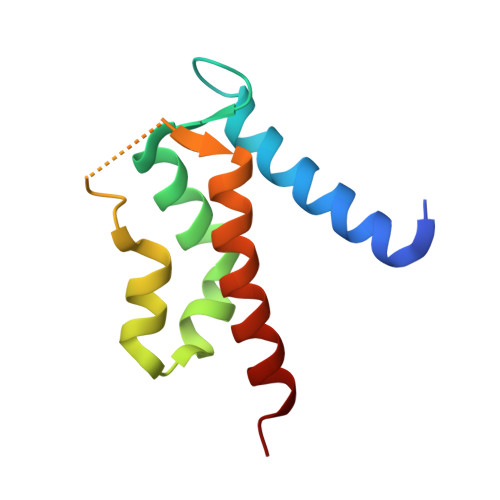The Crystal Structures of Human S100A12 in Apo Form and in Complex with Zinc: New Insights Into S100A12 Oligomerisation.
Moroz, O.V., Blagova, E.V., Wilkinson, A.J., Wilson, K.S., Bronstein, I.B.(2009) J Mol Biol 391: 536
- PubMed: 19501594
- DOI: https://doi.org/10.1016/j.jmb.2009.06.004
- Primary Citation of Related Structures:
2WC8, 2WCB, 2WCE, 2WCF - PubMed Abstract:
The functions of the members of the S100 family of EF-hand proteins are modulated by calcium and, in a number of cases, by zinc or copper. One such protein is S100A12, which is implicated in inflammation and host-parasite responses. Previously, we reported the structures of human S100A12 in both low (dimeric) and high (hexameric) calcium forms and, in addition, that of a complex with copper and calcium. Here we report the crystal structures of the metal-free apo form of human S100A12 at 1.77 A resolution and of the zinc complex in two crystal forms (P2(1)2(1)2(1) and F222) to 1.88 A and 1.73 A resolution, respectively. These are the first structures of a zinc-only complex of an S100 protein to be determined. The zinc complex structure shows significant differences from those of both calcium-loaded and apo-S100A12 structures, and comparisons suggest an explanation for the zinc-induced 1500-fold increase in calcium affinity. In addition, the new structures provide insight into the role of zinc-calcium interplay in the transition of S100A12 from a dimer through a tetramer to a hexamer. The role of both zinc and calcium in target binding by S100A12 during host-parasite responses is confirmed by experiments with paramyosin from the tropical parasites Onchocerca volvulus and Brugia malayi.
Organizational Affiliation:
Structural Biology Laboratory, Department of Chemistry, University of York, Heslington, York YO10 5YW, UK. olga@ysbl.york.ac.uk

















